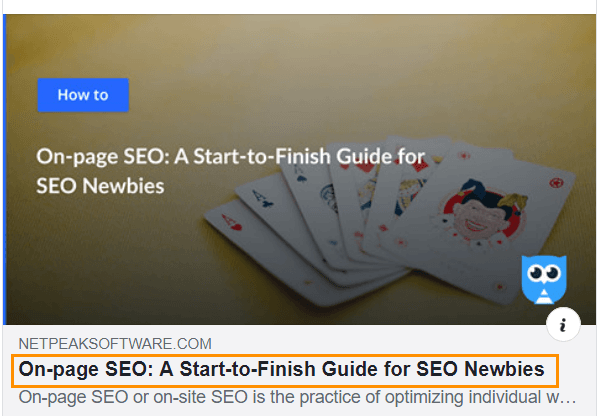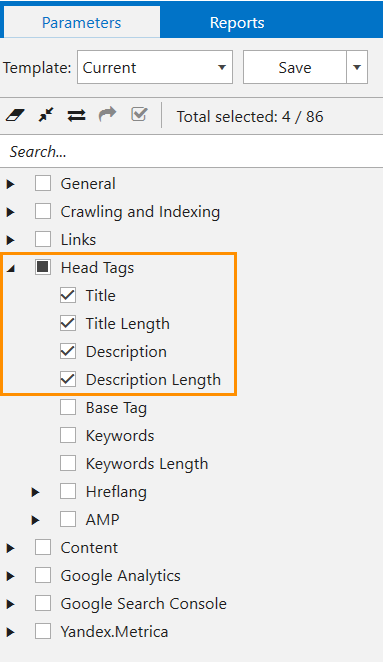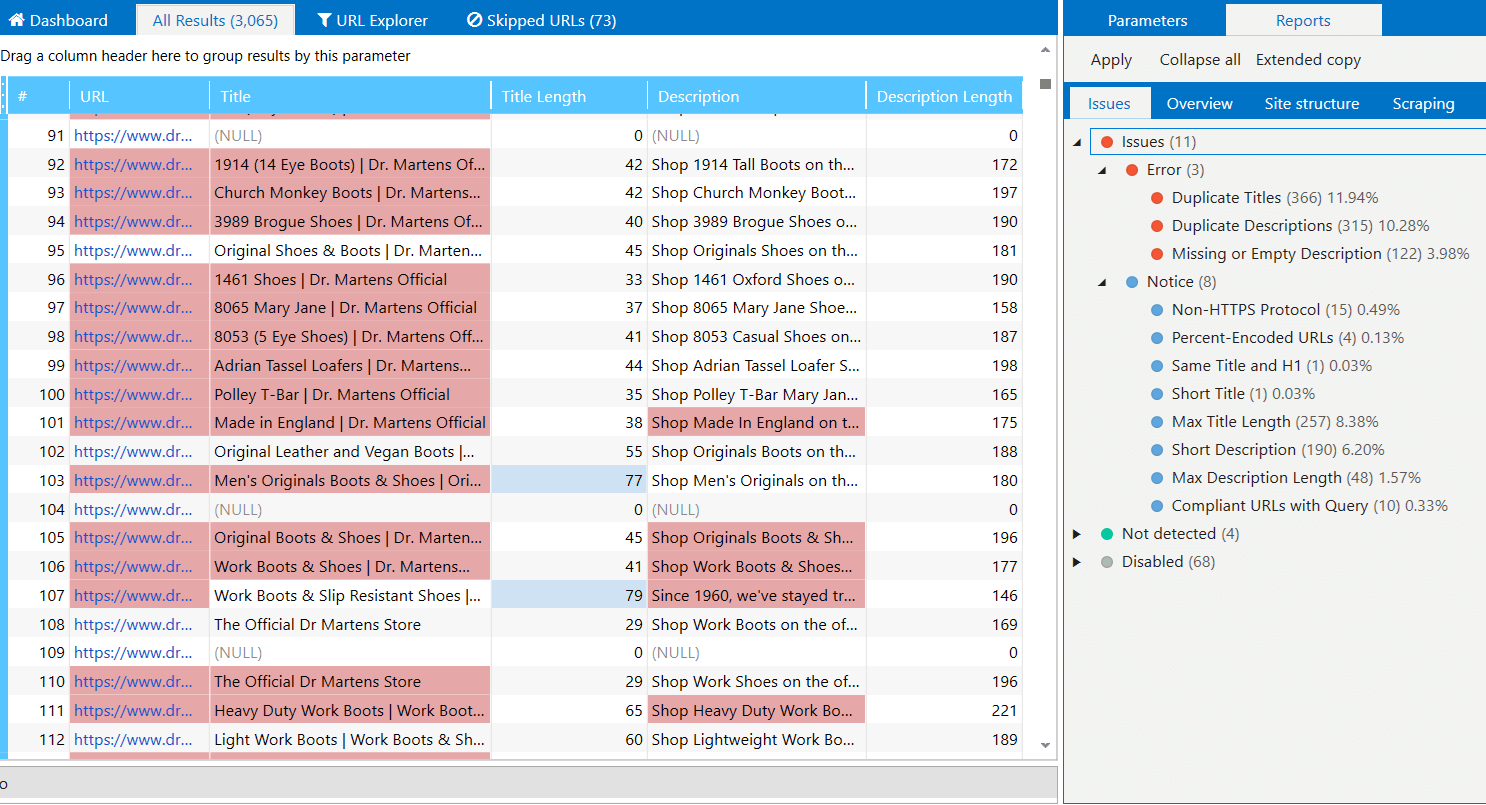What Is a Webpage Title Tag, and How to Create It
How to
Being the main element of the snippet, catchy titles draw users’ attention and help to the final decision: to follow your website or keep looking for another result. In this blog post, we’ll help you figure out what a title HTML is, and how to write a flawless SEO title with a few simple tips.
- 1. What Is a Webpage Title Tag?
- 2. The Importance of Title Tag in SEO
- 3. Frequent Mistakes that You Should Avoid Making in Titles
- 3. How to Create a Flawless SEO Title
- 4. How to Check Title Tag with a Crawler
- Let’s Recap
1. What Is a Webpage Title Tag?
A title tag is an HTML element that dwells in the <head> chunk of the code. It is used to specify the title of the webpage. You can see the title tag incorporation in three places:
- On the search engine result pages (SERPs) as an upper clickable part of the snippet:

- In the browser as a name of the tab:

- In social networks, when you share some post:

Title tag’s backstage:
To see the HTML code of the webpage, simply hit the ‘Ctrl+U’ shortcut.
The work behind the curtains looks like this: search engine robots that use a ‘raw’ piece of code to bring the title tag into the spotlight. However, search robots happen to ignore a defined title and serve up something different instead. You may not know for sure why it happened, but the reasons might be:
- Your title lacks target keywords and doesn’t match the search query.
- On the contrary, your keywords are profusely used in the title impairing its understanding.
- There is an alternative title in other meta tags.
Google’s substitution isn’t always a bad thing. Note that these days search robots are developing their skills in understanding of the natural human language. So they take into account synonyms, conversational phrases, and most importantly, context that frames a word.
2. The Importance of Title Tag in SEO
Title tag acts as a succinct description of your webpage. Basically, it helps both users and search engine robots make sense of your webpage. So title:
- Sets searchers’ expectations. According to your title users get a bit of certainty when clicking on the search result. Forewarned is forearmed.
- Induces users to click-through. First entails the second, which means that a skillfully crafted title meets users’ expectations and induces to click on the result to dig further.
- Creates a first impression. It’s what shows up on the surface that counts. A sloppy piece will make the searcher cringe and keep looking for a better result.
- Works toward brand awareness. Brand words that used in the title increase brand awareness of a fresh business and act as a vote of trust for well-established brands.
In short, title tag acts as a boon both for SEO and marketing. For the first, the end goal is high visibility in search engines and traffic uplift. For the latter, high CTAs, brand awareness and users, converted into customers.
H1 and title tags are usually the same from the copy bent so it adds a bit of ambiguity to this question. Let me clarify.
Firstly, title tag and H1 are completely different HTML tags. Title tag dwells in the <head> part of the code, when H1 in the body. Check it out yourself or take my word.
Secondly, title tag is used as a display feature for snippets, when H1 as a headline for an actual page.

3. Frequent Mistakes that You Should Avoid Making in Titles
Below you will bind the list of the most frequent mistakes that page owners make when composing the title:
- Making the title too long or too short. Note that 50-60 characters are considered to be an optimal length of the title. Longer titles will be ruthlessly truncated by Google.
- Applying the same title for several pages. It creates a duplicate content issue, which negatively affects the indexing of the webpages. Imagine a search robot sees two identical titles and wonders which one is original and should be indexed and brought up on the SERPs.
- Copying the title from other websites. First, you risk never to catch up on your competitors this way. Second, why? Two identical titles aligning on the search result pages are unlikely to bring you desired click-through?
- Writing for robots, not for humans. Keyword-stuffed titles worked okay way back in the past before Google had introduced its algorithms. Even though you may want to place a target keyword in the first place, make sure you don’t create an unintelligible mess.
- Dezert title tags on other pages. If the website is huge, such things as filling all title tags can easily fall through the cracks. But take care of it and check for title tags regularly.
3. How to Create a Flawless SEO Title
To make up a correct SEO title, you need to follow the basic rules set by search systems:
3.1. Use Keywords
Since title tag is an SEO battlefield that requires a thought out strategy, we’ll start straight from the get-go – the keywords. Why so much buzz about the keywords? Keywords and phrases in your title make it possible for people to find your site via search engines. It means that they type a query into the search bar and they receive results that contain that phrase in the title and / or description. Here’s the example:

What keywords should I use?
At this stage, you should distinguish two types of keywords:
- High-frequency – these are flagship (or primary) keywords that are guaranteed to appear in search results. The trick about these keywords is that it’s hellishly difficult to rank for them, especially if you promote in the highly competitive niche occupied by brand giants.
For instance, in SEO, the MOZ blog is a long-established and trustworthy community, so almost any question has been already disclosed there. Quite often, their results appear in the #0 position (so-called ‘featured snippet’) of search results.
When your brand is only staging its authority, it will be tough to outrank this giant. But does it mean that there is no chance at all? Of course, it doesn’t. You still can rank high or even higher when you perfect your SEO performance in detail.
So let’s say that our primary keyword phrase is ‘On-page SEO.’
- Long-tail keywords – these low-volume keywords (3+ words) that are used for search occasionally, but they contain the specs, framing one primary keyword into the context. So this is a long-tail variation:

If you target specifically for a primary keyword, know that it’s a time-consuming undertaking. That’s why you should apply this formula when crafting your title:
3.2. Language
When crafting the title, focus on your target audience, their needs, and the language they speak. Such walk-in-my-shoes practice helps to create a title that meets expectations. Basic rules for an up-and-coming title:
Rule #1: Be descriptive – users should open your page with a preliminary understanding of what the page is about.
Rule #2: Be concise – shadowy titles with abundant adjectives may demonstrate your profound writing skills, but a true marketer will try to interact with the users on this stage and provide as much value as possible.
Rule #3: Use keywords.
The most hands-on approach is to create a generic title first. This kind of title is plain and it contains the main keywords. Like:
What Is On-Page SEO?
Should I create plain titles to rank?
Don’t be stingy on words. The point is to add beef later.
To do so, think about the additional value that your webpage suggests. If you write a guide, can you say that your guide covers all sore points of your users and you can describe it as a ‘comprehensive,’ or ‘start-to-finish,’ or ‘ultimate,’ etc? Is this guide intended for readers with a hefty professional background? Or for beginners?
This is how we wrote the title for one of our blog posts. First, we placed the target keywords, then we specified what sort of guide it is, and for whom it is intended. The expectations are set crystal clear here.

Don’t go overboard with adjectives that refer to emotions (‘a guide that you’ll definitely love,’ ‘sth you should not ignore,’ etc), and words in superlative form like ‘best,’ ‘most,’ etc. The thing is that their acclaim is gradually fading and modern people perceive it as the same old same old.
Use brackets to add the specs to the title. It’s a good practice that drives attention.

And use the brand words because people follow the brands they trust. Meatime, remember that the title space is not limitless and that the brand name will be, most undoubtedly, truncated in a long title.

3.3. Make Titles Unique
Create unique tags for every webpage. No one likes duplicates, neither your users nor search engines will appreciate this. However, there are thousands of legit reasons why a duplicate may occur. Consider setting rel=canonical tag to the original page that should be indexed.
In case your site contains a big number of pages, opt for a convenient and helpful title generator.
3.4. Titles for Local SEO
Mention the region in the title if you sell products strictly within a particular locale. This is how it may look like:
Read more → Title tag checker
4. How to Check Title Tag with a Crawler
You can check every single page of your website manually with a ‘Ctrl+U’ shortcut or selecting a ‘View a page source’ option. But trust me, you’ll get old earlier than you finish, if your website has 30+ thousand pages. The solution is to include automation to the SEO grind.
There are many tools on the market that will manage these basic tasks. But there are also more advanced tools that are used for a broader range of SEO purposes. Netpeak Spider perfectly fits both demands, so I’ll use it to show how to crawl title tags on the website in bulk.
You can check title tags and work with other basic features in the free version of Netpeak Spider crawler that is not limited by the term of use and the number of analyzed URLs.
To get access to free Netpeak Spider, you just need to sign up, download, and launch the program 😉
Sign Up and Download Freemium Version of Netpeak Spider
P.S. Right after signup, you'll also have the opportunity to try all paid functionality and then compare all our plans and pick the most suitable for you.
- Launch Netpeak Spider.
- Enter a website’s URL into the ‘Initial URL’ field.
- Go to the parameters in a sidebar and select ‘Title,’ and ‘Title Length’ in the ‘Head Tags’ group. I also recommend ticking ‘Description,’ and ‘Description Length’ since you should monitor these two meta tags along with each other. Leave other parameters unticked – you won’t need them at the moment.

- Hit the ‘Start’ button to start crawling.
- When the crawling is completed, you’ll see the results in the main table, and the issue overview in a sidebar.

- To have an opportunity to work with results, go to the ‘Export’ tab in the upper right corner, and export the table in any format needed.
Let’s Recap
Title tags are useful for site visitors and significantly contribute to page promotion. With the help of titles, you can specify the page’s message and draw users’ attention. If the tag stands out from your competitors, you’ll manage to attract more traffic to the site. To craft a decent title always remember to:
- Use keywords
- Write for humans, not for robots
- Provide value
- Be descriptive and concise
- Don’t go overboard with 'clutter' words


